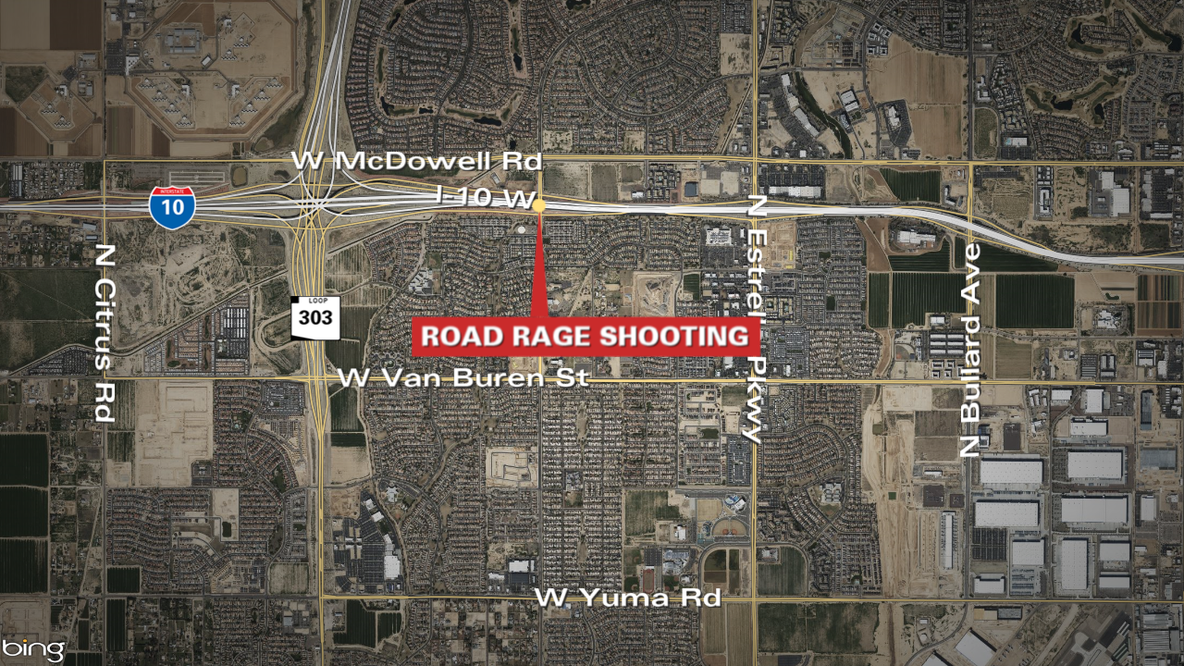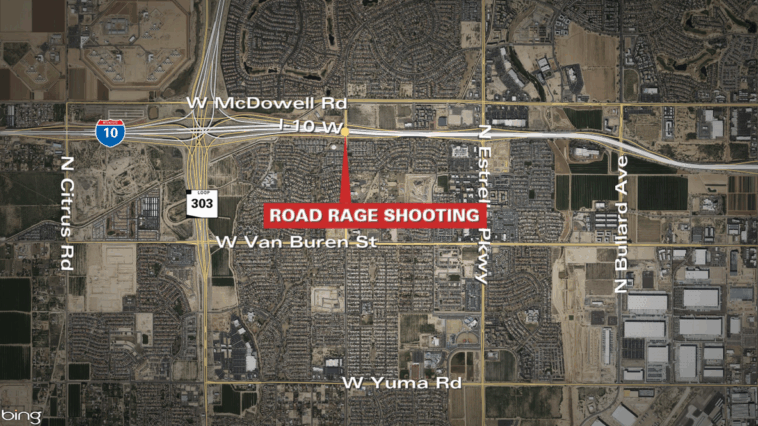

An Unsettling Incident on I-10: Reflecting on Road Rage and Public Safety
The recent road rage shooting on Interstate 10 in Goodyear, Arizona, has stirred up deep concerns about personal responsibility, the role of law enforcement, and the overall culture of driving on modern highways. Early Sunday morning, just after 4 a.m., a reported incident unfolded where, amid a sudden burst of rage, one driver opened fire on another vehicle. While thankfully the injury was non-life-threatening—a gunshot wound to the leg—the event raises many questions about accountability, preventative measures, and the legal process surrounding such attacks. In this opinion editorial, we take a closer look at the event, its legal ramifications, and what might be done to help steer through these troubling dilemmas.
This piece aims to explore not only the immediate aspects of the event but also the broader implications concerning highway safety initiatives in Arizona. As a community, it is vital that we understand the tangled issues involved in road rage incidents and think critically about how the legal system, local law enforcement, and public policy can work together to create safer roadways for everyone.
Understanding the Incident: What Really Happened on the Highway?
According to the Arizona Department of Public Safety (DPS), the incident near Estrella Parkway was triggered by a road rage situation that quickly escalated into violence. Two vehicles, caught in a surge of heated emotions, became the scene of a shooting wherein one vehicle was targeted multiple times. The driver who was shot suffered a gunshot wound to the leg and was promptly taken to a nearby hospital for treatment.
While the details of the confrontation remain under investigation, the episode serves as a stark reminder of how quickly a seemingly mundane drive can spiral into a nerve-racking, off-putting conflict. Given that the suspect’s custody status is still uncertain, questions hover over the efficiency of law enforcement efforts and the strategies employed to prevent such occurrences from intensifying.
Legal Responsibilities and the Role of Law Enforcement
Assessing Arrest Procedures in Road Rage Cases
In incidents like these, the role of the DPS and local law enforcement is critically important. The responsibility to ensure public safety and to secure a conviction in cases of road rage incidents involves multiple steps:
- Responding quickly to the scene of the crisis
- Collecting and preserving crucial evidence such as witness statements and security footage
- Interrogating potential suspects while respecting legal rights
- Ensuring due process and the protection of individual rights during investigation
Each of these responsibilities represents one of the tricky parts in the handling of volatile incidents. Missteps can lead to convoluted legal battles or unsuccessful prosecutions—situations that leave victims and society at large feeling deflated and wary of future events on high-speed roadways.
The Importance of Quick Action by DPS
One of the key aspects in such investigations is the prompt and efficient response by DPS personnel. Their ability to get to the scene, collect evidence, and ensure the safety of all involved is essential. Unfortunately, road rage incidents come loaded with unexpected twists and turns that can challenge the ability of law enforcement to manage the situation successfully. As the investigation continues, many in the legal community are watching closely to see if the DPS will manage their way through the complicated pieces involved, balancing rapid response with careful collection of evidence.
Evaluating the Legal Ramifications of Road Rage on Highways
Distinguishing Between Civil and Criminal Responsibility
When incidents like this occur, the legal discourse typically divides into two categories: civil liability and criminal responsibility. On the criminal side, the perpetrator may face charges ranging from assault with a deadly weapon to attempted manslaughter, depending on the severity of the attack and the injuries sustained. On the civil side, the victim may decide to file a lawsuit for damages related to medical expenses, psychological trauma, and other losses.
In either arena, there are many confusing bits of the law that make such cases hard to untangle. Not only do we have to consider the obvious charges resulting from the use of a firearm in a public setting, but there are also additional layers that involve the particularities of self-defense claims, duties of care, and potential liabilities of passengers or even witnesses.
Statutory Interpretations and Their Impact on Proceedings
The legal community must carefully poke around the statutory interpretations that define the permissible use of force on public highways. For example, many states have enhanced penalties for crimes committed in areas deemed to be high-risk, such as busy interstate highways. This approach is intended to manage public safety in densely populated or highly trafficked areas. However, it also introduces subtle details into sentencing guidelines that judges must consider on a case-by-case basis.
Effective prosecution requires that prosecutors get into these complicated pieces of evidence while balancing the principles of justice and fairness. The jury must also figure a path through conflicting testimonies and circumstantial evidence in order to reach a verdict that not only penalizes the wrongdoer but also discourages similar behavior in the future.
Challenges in Prosecution and the Need for Clear Legal Frameworks
Cases of this nature can be intimidating for both the defense and the prosecution. The suspect’s legal team may argue that the situation was full of problems, loaded with tension, or even that there were subtle influences leading to the shooting. At the same time, the DPS must ensure that every fine point of the evidence is carefully documented. This balancing act is nerve-racking for the entire legal community, where even the smallest oversight can become a source of public mistrust.
In response to these challenges, legal professionals have called for clearer statutory guidelines that address road rage incidents specifically. The aim is to reduce ambiguity in legal proceedings and to create a more transparent path for those involved. Without these reforms, we risk leaving our courtrooms fraught with tangled legal debates that do little to serve justice.
Highway Safety Initiatives: Legal and Policy Considerations
Statewide Efforts to Reduce Road Rage Incidents
The recent incident in Goodyear forces us to examine broader highway safety initiatives. Arizona, like many states, is grappling with a growing number of violent confrontations on the roadways. While initiatives often include technical measures such as speed monitoring and surveillance cameras, they also need to account for the underlying social tensions that lead to these acts of violence.
Several policy adjustments might help alleviate the pressures that lead to road rage. These include:
- Investing in advanced training programs for law enforcement to manage volatile situations
- Implementing community outreach programs that address stress and anger management among drivers
- Reviewing traffic laws to ensure rapid intervention during emergencies
- Coordinating with mental health professionals to support individuals at risk of engaging in violent behavior
By focusing on these areas, state officials can set the stage for a more holistic approach to highway safety. The challenge, however, lies in identifying which measures are most effective and ensuring that these policies are implemented in a timely manner. Ultimately, our roads must transform from venues of potential conflict into safe, accessible highways for every user.
Community Involvement in Traffic Safety Campaigns
A key component of any long-term solution is community involvement. When residents take a proactive role in addressing road safety, they can help bridge the gap between policy and real-life implementation. Local campaigns should focus on spreading awareness about the consequences of aggressive driving, encouraging bystanders to report potential conflicts before they escalate, and promoting programs that help drivers manage their stress on the road.
Engaging the community can be done in a variety of ways, including:
- Local workshops on conflict de-escalation techniques
- Collaborations between law enforcement and community centers
- Online safety forums where drivers can share experiences and advice
- School-based seminars for younger drivers focusing on responsible driving
These localized, hands-on efforts are super important for establishing a lasting culture of peace and civility on the nation’s highways.
The Societal Impact of Road Rage: Beyond the Immediate Incident
Psychological Effects on Victims and Witnesses
While the physical harm from a road rage incident such as the shooting on I-10 might be limited to a non-life-threatening injury, the psychological toll can be immense. Victims often experience a range of emotional responses, from anxiety to post-traumatic stress. Witnesses, too, may carry long-lasting memories of the event that influence how they interact with traffic and perceive public spaces.
These psychological effects are a critical aspect of any legal case involving violent confrontations on the road. They remind us that the repercussions of road rage run far deeper than the tangible injuries and extend into the subtle parts of a person’s mental well-being. As courts evaluate damages related to personal injury, the hidden complexities involved with emotional trauma must be carefully addressed.
Community Trust in the Legal and Law Enforcement Systems
Public trust is necessary for the effective functioning of any legal and law enforcement system. Every time an incident of road rage is handled promptly and professionally, it bolsters community confidence. Conversely, any missteps—whether perceived or real—can cause lasting damage to that trust.
Residents of Arizona expect their law enforcement agencies to get around potential problems quickly and confidently. They look for reassurance that incidents, no matter how intimidating, are handled with precision and empathy. This trust is built on transparency, accountability, and open communication between the public and the police. As such, the DPS must continue providing updates and actively responding to community feedback, ensuring that the investigative process is both thorough and accessible to all.
Preventative Measures and the Legal Tools Needed to Tackle Road Rage
Strengthening Legal Incentives for Conflict Prevention
One of the most effective ways to combat road rage is to create legal incentives for behavior that de-escalates rather than intensifies highway conflicts. The law must be adapted to not only punish violent behavior, but also to reward interventions that help prevent such situations before they escalate.
Potential legal strategies could include:
- Amending local statutes to include mandatory anger management courses for offenders
- Creating clear, widely known guidelines on acceptable forms of dispute resolution in traffic incidents
- Introducing community service obligations specifically targeted at reducing volatile driving habits
- Leveraging technology to provide real-time alerts to drivers, warning them of potential road hazards or incidents nearby
By finding your way through these legal adjustments, lawmakers can help strike a delicate balance between punitive measures and proactive interventions—a strategy that not only holds offenders accountable but also works towards preventing future outbursts.
Utilizing Technology and Data in the Fight Against Road Rage
Modern technology can play a significant role in managing highway safety. For instance, advanced traffic monitoring systems and surveillance cameras can capture critical details in the aftermath of incidents. These tools provide law enforcement with the nitty-gritty of events, making it easier to piece together what exactly happened and who is responsible.
Technology can also aid in predictive analysis. By combing through historical data concerning road rage incidents, patterns may emerge that help predict when and where future incidents are likely to occur. With this information, DPS can figure a path through potential issues by deploying resources more effectively, ensuring a more rapid response to emerging conflicts.
A sample table of technology-driven safety initiatives might look like this:
| Initiative | Description | Expected Benefit |
|---|---|---|
| Real-Time Traffic Alerts | Provides immediate warnings to drivers about incidents ahead | Reduces collision risks and allows time for intervention |
| Surveillance Enhancement | Deploys cameras along high-traffic corridors to capture evidence | Aids in law enforcement investigations and deters potential offenders |
| Data Analytics in Policing | Aggregates incident reports to forecast area hotspots for road rage | Optimizes police patrol routes and enhances preventive measures |
These measures represent only a part of a comprehensive strategy to band together legal tools and technological progress in order to create a safer driving experience.
Looking Forward: Policy Recommendations and Legal Reforms
Modernizing Statutory Laws to Reflect Today’s Realities
The event on I-10 is a wake-up call for policymakers and legal experts alike. As society evolves, so must the legal framework that governs behavior on our roads. Governing bodies need to take a closer look at existing traffic regulations and criminal statutes, reassessing them in the context of modern driving conditions and technologies.
Future legislation should focus on:
- Clarifying definitions of aggressive driving to avoid interpretative ambiguities
- Establishing new penalties for acts that cause significant public alarm, even if injuries are minor
- Integrating community-based interventions in sentencing and rehabilitation
- Enhancing cooperation between local law enforcement, public safety agencies, and mental health services
While there is no one-size-fits-all solution, these legal reforms are key to ensuring that individuals are held accountable for their actions while also receiving the necessary support to transform their behavior. It is super important that legislative reforms are made in collaboration with experts in psychology, law enforcement, and traffic safety, so that the outcomes are balanced and equitable.
Developing Interdisciplinary Task Forces for Road Safety
Given the many subtle details and hidden complexities involved in road rage incidents, there is a strong case for the formation of interdisciplinary task forces. These groups would combine the expertise of law enforcement professionals, psychologists, legal experts, and community leaders to design comprehensive strategies aimed at reducing violent incidents on the roadways.
Some key benefits of this model include:
- A holistic understanding of the triggers behind road rage
- More effective conflict de-escalation techniques developed in collaboration with mental health professionals
- Improved legal procedures that consider both preventative and punitive measures
- Enhanced public trust through community-driven strategies and direct involvement
Interdisciplinary task forces are not a panacea, but they do provide a framework where multiple perspectives converge. This collaborative approach makes it easier for policymakers and law enforcement to work through the tangled issues that have long plagued highway safety, while also taking into account the nerve-wracking nature of these incidents for affected drivers and citizens alike.
Reflecting on Broader Social and Cultural Implications
Changing Cultural Attitudes Towards Aggressive Driving
The road rage incident on I-10 is symptomatic of a larger cultural shift in how individuals engage with one another in high-pressure environments. As daily stresses build and frustration mounts, aggressive driving becomes a dangerous coping mechanism that not only endangers lives but also undermines the collective trust in communal spaces—like our highways. In this context, it is necessary to probe into the reasons behind such behavior, including societal pressures, inadequate stress management, and even the influence of media portrayals of conflict.
Changing these cultural attitudes requires more than punitive measures. Public education should emphasize the nerve-wracking consequences of road rage, using real-life examples to highlight its far-reaching impacts. Educational campaigns can use:
- Real stories from victims and rehabilitated offenders
- Workshops in community centers and schools
- Collaborations with local media for positive messaging
By getting into these complicated pieces from both a legal and community perspective, we can aspire to create a driving culture that prizes patience and peaceful resolution over impulsive violence.
The Impact on the Legal Profession and Judicial Systems
Every road rage incident that reaches the courtroom adds another layer of discussion to the evolution of legal precedents. Courts often find themselves sorting out cases where subtle details—like the intent behind a driver’s actions or the fine shades separating self-defense from unprovoked violence—play a decisive role in the final verdict. These cases test the resilience and adaptability of our judicial systems, forcing judges and lawyers alike to figure a path through emerging legal challenges.
For the legal profession, this period is one of both challenge and opportunity. Each case contributes to a broader understanding of how to manage public safety cases in a way that respects the rights of all individuals while maintaining order on our highways. It is a testament to the dynamic nature of the law, which must continuously evolve alongside societal changes.
Barriers and Opportunities in Addressing Highway Violence
The Role of Community Advocacy Groups
On various fronts, community advocacy groups have risen to prominence as catalysts for change. These organizations are often in the best position to identify the small distinctions between what happens in an isolated incident and what these episodes imply for society at large. Many local groups argue for better counseling services for drivers, improved traffic management solutions, and more robust legal frameworks that address highway violence.
Steps community groups might advocate for include:
- Establishing neighborhood watch initiatives focused on traffic safety
- Lobbying for increased funding to support mental health resources for drivers
- Organizing public forums where law enforcement can interact with residents
- Campaigning for clearer signage and communication on high-risk roadways
Such grassroots efforts are essential for creating a comprehensive safety net. They underline the fact that some of the most effective legal and policy changes arise from sustained, community-driven pressure—an effort that must be applauded and actively supported.
Economic and Social Costs of Road Rage Incidents
While the immediate concern in any violent incident is the human tragedy it entails, the economic and social costs are equally important to consider. From skyrocketing insurance premiums to the loss of productivity due to road blockages, road rage unleashes a severe economic burden on communities. Additionally, the long-term impact on mental health and community cohesion can’t be underestimated.
Taking a broader look, the expenses incurred by such incidents include:
- Increased emergency response costs and hospital bills for minor injuries
- Higher costs to insurers due to a surge in claims arising from violent incidents
- Losses in productivity for affected businesses and individuals
- Costs related to legal proceedings and prolonged court cases
Addressing these economic ripples requires a multifaceted strategy—one that combines legal enforcement with community support and public policy adjustments. It also calls for a rethinking of how we measure the value of safe roadways, not only in economic terms but as a critical component of overall societal well-being.
Steps Forward: Legal Reforms and Community Initiatives
Implementing Comprehensive Road Safety Education Programs
To mitigate the risk of further incidents, there is a pressing need for a robust educational framework that targets drivers of all ages. Many successful models from other regions have shown that targeted educational programs can significantly reduce the occurrence of aggressive driving behaviors. These programs can include:
- Mandatory defensive driving courses for all new drivers
- Workshops that emphasize patience, self-control, and awareness on the road
- Collaborative programs involving local law enforcement and mental health experts
- Online platforms offering continuous education about traffic safety and conflict resolution
Such measures not only help drivers figure a path through challenging road conditions but also serve as an early intervention tool, turning nerve-wracking encounters into teachable moments that have long-lasting benefits for all involved.
Improving Legal Recourse for Victims of Road Rage
It is also essential to enhance the legal avenues available for victims of road rage. The legal system should offer not just punitive measures against the perpetrators but also robust support structures for those who have suffered trauma. This may involve:
- Streamlined processes for filing claims against offenders
- Provision of free legal counsel for victims unable to afford representation
- Legislation that holds driving schools and rental companies partially liable for inadequate training or negligence
- Establishment of victim support groups to help survivors manage the aftermath of traumatic driving incidents
By taking these steps, the legal system can better acknowledge the full spectrum of impacts road rage has on individuals and communities alike. The goal is to ensure that victims do not just suffer in silence but receive the care and recognition they need during and after their ordeal.
Final Thoughts: Building Safer Highways and Resilient Communities
The I-10 incident in Goodyear serves as a stark example of how quickly isolated acts of aggression can ripple out into broader societal issues. It calls on us all—lawmakers, law enforcement, and the community—to reexamine our approaches to road safety and legal accountability. While the investigation continues and the suspect’s status remains unresolved, we need to focus on long-term solutions that reduce the chances of future occurrences.
It is not enough to simply react to these events once they occur. We must work proactively—by investing in technology, reviewing legal frameworks, and promoting community-based initiatives—to find our way through these challenging issues. Only with a comprehensive strategy that includes legal reforms, educational efforts, and community engagement can we hope to make our highways truly safe for everyone.
This incident reminds us that while the physical scars may heal, the psychological and societal impacts of road rage can linger for years. As responsible citizens and as members of the legal community, we must stay vigilant, ensuring that justice is served and that the chilling possibility of similar incidents is minimized.
In reflecting upon this episode and its many subtle details, it becomes clear that our highways are more than just segments of asphalt—they are vital arteries that connect communities, economies, and lives. Protecting these corridors demands that we maintain a constant dialogue about safety, accountability, and reform. The ultimate aim is to transform these nerve-wracking experiences into catalysts for enduring change—a shift from reactive measures to proactive prevention.
With every legal reform and policy initiative, each community outreach effort, and every moment of reflection spurred by incidents like the Goodyear road rage shooting, we take a step toward a future where our highways are not full of problems but exemplify safe passage and mutual respect among drivers. The responsibility lies with all of us: lawmakers must craft effective, clear statutes; law enforcement must be prepared to manage these dramatic, tense situations; and, importantly, we as a community must do our part by embracing peace behind the wheel.
In conclusion, while the details of that early Sunday morning remain under investigation, the path forward is filled with opportunities to address not only the immediate legal concerns but also the broader cultural shifts needed to foster a safer driving experience. By reviewing the fine points of this incident and applying lessons learned, we can work together to transform the twists and turns of road rage into a more measured, just, and ultimately safer society.
As we continue to monitor the developments of this case and similar incidents, let us ask ourselves: What more can be done? How do we encourage accountability and restraint among drivers? The answers lie in our collective resoluteness to re-legislate the culture of driving—ensuring that every journey, whether mundane or extraordinary, is one where safety and respect lead the way.
The road ahead may be riddled with tension and challenging legal bits, but with community engagement, dedicated law enforcement, and thoughtful legal reforms, we can build highways that are not just corridors for vehicles but safe spaces for all who travel them.
This opinion editorial is a call to action for legal professionals, policy makers, and everyday citizens to get into a deeper conversation about road safety and legal accountability—a conversation that is off-putting to ignore, given the profound impact on our collective well-being.
Let this incident on I-10 serve as both a warning and an opportunity—a chance to learn, adapt, and create a safer future for every driver. Together, we can figure a path through the nerve-wracking challenges of today’s dynamic world, ensuring that the lessons of the past pave the way for a more secure, just, and peaceful tomorrow.
Originally Post From https://www.abc15.com/news/crime/dps-investigating-reported-road-rage-shooting-on-i-10-in-goodyear-sunday-morning
Read more about this topic at
AI version of dead Arizona man addresses killer …
Two arrests made in deadly Midwest City road rage shooting


